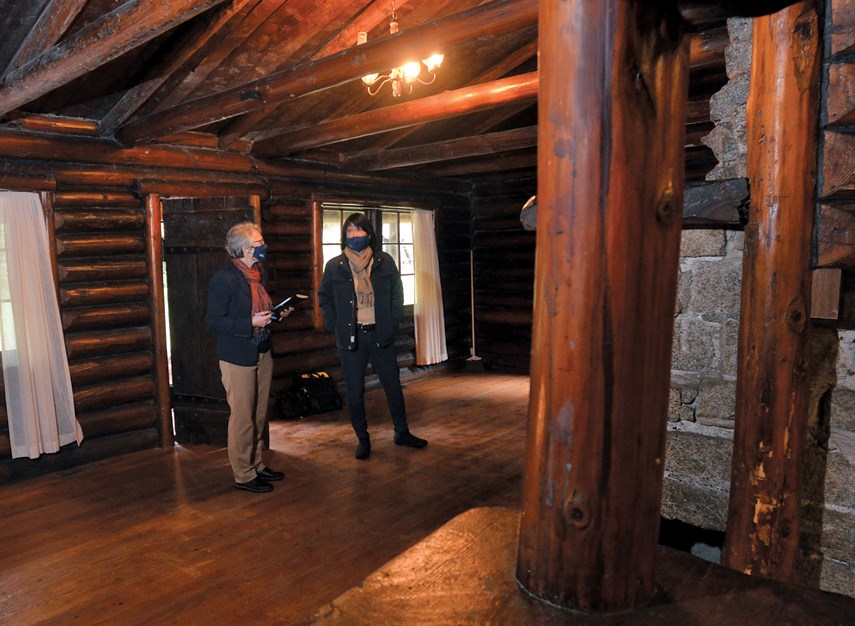It’s been on screen more than Nicholas Cage and with a bit of maintenance, it might surpass Samuel L. Jackson.
The District of North Vancouver’s Murdo Frazer cabin is about to get some major work done to extend its life, thanks in part to a grant from Heritage BC.
The property just west of Edgemont Village was originally purchased in 1936, the year before the Lions Gate Bridge began construction, by Victor Golden, a Shaughnessy business man who wanted a wilderness hunting lodge. By 1951, he had developed the property with the main cabin, guest house, covered BBQ, plus a carport and manmade duck pond, all of which are still there.
The district acquired the land in 1969 and incorporated it into Murdo Frazer Park, five years after the Upper Levels Highway was completed just 250 metres away. For a time, the cabin was lived in by the park’s caretakers, a practice that has fallen out of fashion. Now it is exclusively used for filming.
Legend has it the cabin's big break in show business came in the late 1980s or early '90s when it was MacGyver’s cabin. Then it was a regular on Stargate SG-1. Perhaps most famously, its massive stone hearth was used for the Shaw Yule Log. More recently it has appeared in Netflix’s Virgin River, Nancy Drew on The CW, Disney’s Once Upon a Time, Supernatural, and The Flash - plus heaps of commercials, including a memorable Kokanee beer campaign, said Alice To, the district’s filming co-ordinator.
“The sasquatch ran around here for a bit,” she said with a laugh. “And the Kokanee girls.”
Location scouts in Hollywood North love it because it gets them an authentic cabin in the woods without having to venture into the actual wilderness.
“We're 10 minutes outside of an urban area and you can have this look for film. That's why this is such a unique property,” To said.
But, after so many years, it's showing its age. Reaching down to touch one of the corner posts, the log splinters in district planner Tamsin Guppy’s fingers.
“That shouldn’t happen,” she says.
Golden’s decision to divert streams into a duck pond all willy-nilly created drainage problems, with water pooling under the cabin and mould creeping inside, said Guppy. She fully expects they’ll find more work that needs to be done as they get a closer look at the bones of the structure.
“You know how it is with old buildings,” she said. “It's a lovely asset and the longer you let a building deteriorate, both the harder it is to preserve and the harder it is to refurbish it at the end of the day. So, stepping in while you still have something you can preserve is incredibly important.”
They estimate it will be $500,000 of work. Heritage BC’s grant will put up $287,000.
There is no guessing how much longer the building would last without the work, but Guppy said the district likely would have pursued the upgrades even without the grant because they expect a return on their investment.
The cabin averages 12 productions per year, To said. At $2,500 per day to shoot at the cabin and surrounding park, it provides a lot of revenue. In 2019, the cabin earned $76,000 for the district.
“We're preserving an asset, which is part of the local film industry's repertoire of buildings, which helps support filming on the North Shore, which in turn helps support not just the film jobs, but those spin-off jobs, like the caterers and so on, that are so much locally based,” Guppy said.
There will be no lights, camera or action while the work is being done later this year, but the timing is good, To said. BC Hydro has begun the massive task of replacing the Murdo Frazer substation just west of the cabin. While that happens for the next two years, filming wouldn’t have been allowed in the park.
In 2018, district council gave the cabin heritage designation, in part because of its rustic log architecture – a form of building that fell out of favour with the advent of the sawmill, but experienced a revival in the post-war period when an improving economy led to a boom in interest for rustic recreational properties. But also because its use in film has imbued with a heritage value it wouldn’t otherwise have.
"[It’s] in all of these different stories that are part of our culture, right? So it's got these extra layers of history on it,” Guppy said.



